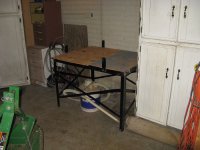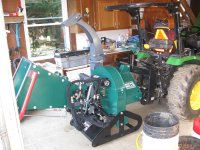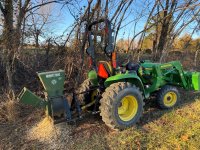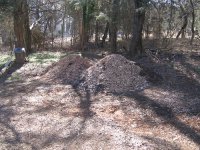frogpond
Silver Member
Hi Freep,
I certainly see the virtues of a pto chipper, especially in terms of power, but as you say, in some situations, a standalone can do what is needed.
I am not so particular about chip size. Mostly, I'm just trying to deal with the piles of limbs and small trees that result from our cleanup and selective thinning work.
I took a look just now at the dosko and Nova machines, and I have a few thoughts. Other things to consider: Does the discharge chute rotate? This is actually quite useful. How high do you have to lift material to feed it? If you have vine maple or other leggy stuff, it can be quite a struggle to lift it close to vertical, and hold the butt end 4 or 5 feet in the air. Will the machine self-feed, either by grabbing the material in the knives, or by mechanical or hydraulic systems? Very important. And probably the most important: how big is the feed opening. 5x5.5" (dosko) is theoretically fine for 4" limbs, but a lot of them have crooks and side branches that you will have to cut to get them into that small an opening.
Oh, and even though the dosko is only 350 pounds, you will find it hard to move around by hand unless the ground is flat and smooth. Better get the tow package.
I will be curious to hear what you end up with.
I certainly see the virtues of a pto chipper, especially in terms of power, but as you say, in some situations, a standalone can do what is needed.
I am not so particular about chip size. Mostly, I'm just trying to deal with the piles of limbs and small trees that result from our cleanup and selective thinning work.
I took a look just now at the dosko and Nova machines, and I have a few thoughts. Other things to consider: Does the discharge chute rotate? This is actually quite useful. How high do you have to lift material to feed it? If you have vine maple or other leggy stuff, it can be quite a struggle to lift it close to vertical, and hold the butt end 4 or 5 feet in the air. Will the machine self-feed, either by grabbing the material in the knives, or by mechanical or hydraulic systems? Very important. And probably the most important: how big is the feed opening. 5x5.5" (dosko) is theoretically fine for 4" limbs, but a lot of them have crooks and side branches that you will have to cut to get them into that small an opening.
Oh, and even though the dosko is only 350 pounds, you will find it hard to move around by hand unless the ground is flat and smooth. Better get the tow package.
I will be curious to hear what you end up with.





